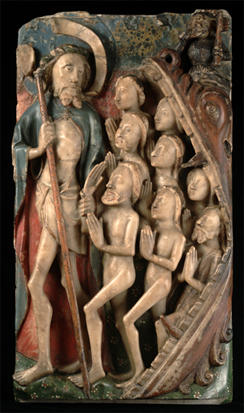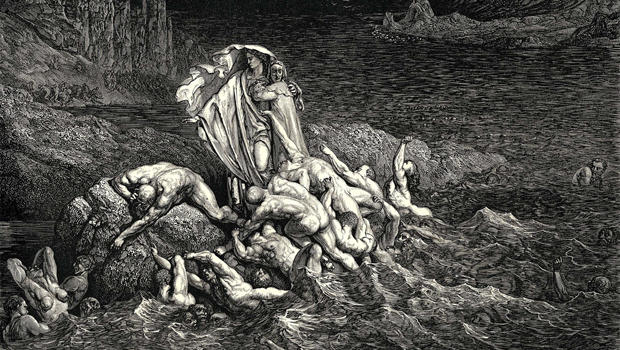
"The Disputation of the Sacrament" (1509-10) by the Italian Renaissance artist Raphael, in the Apostolic Palace at the Vatican. CBS News
"Upstairs/Downstairs" could describe two very different visions of the afterlife . . . one of which seems particularly frightful in these days before Halloween. Martha Teichner takes us on a tour:
The members of Temple Baptist Church in Knoxville, Tenn., may sing about heaven . . . but over the years, their pastor, Charles Lawson, has often warned them about hell.
"Deeper and deeper and deeper you go into the bottomless pit," he preached. "The horrors rise up beside you, the sound and the screams and the smell and the fire, all encompasses you. Because you're dropping down into the land of the condemned."
Where did those images come from? Well, for starters, not really from the Old Testament.
Dale T. Irvin, president of the New York Theological Seminary and a professor of World Christianity, says that in the Old Testament, "Hell is a shadowy place. It's a place of sleep."
It was not the place of eternal damnation we think of today. Instead, it's a vision shaped by Hades, the underworld of Greek mythology.
Irvin says initially, in the Old Testament, hell was not about punishment -- that came later, with interpretations of the New Testament.
"What about the Biblical references to heaven?" asked Teichner.
"Heaven, for the Bible, is the place that's over our heads," Irvin said. "It's the sky, and it's a place where God lives."
From the earliest times, heaven has been up -- and that other place, down.
Hell had become hellish by the Middle Ages -- and heaven, heavenly. Dante's "Divine Comedy," with its bizarre, layered visions of heaven and hell -- like the New Testament Book of Revelation on steroids -- had a huge impact. Soon, in Europe, all you had to do was go to church and look up. On the frescoed ceiling of a dome in the cathedral in Parma, the artist Corregio introduced the idea of a sort of "great stadium of heaven," said Townsend, "this idea that the saints, God and the virgin, and your loved ones are all in the clouds." And in Florence's Great Baptistry, a vision of hell. "I walk into a church and I see this monster eating people, and serpents -- it's pretty gruesome," said Teichner. "It would put the fear of God into you," Townsend said. And that was the point. Even movie versions pretty much conform; there are lots of fluffy clouds in the animated film, "All Dogs Go to Heaven," and in Woody Allen's "Deconstructing Harry," hell is a place hot and terrible. So today, if you were making a film like "Heaven Is for Real," intended to please audiences of all faiths, how would you decide what heaven should look like? Screenwriter-director Randall Wallace went for simplicity. "First of all, 'Heaven Is for Real' is the story of a four-year-old boy's account of heaven. Ultimately, for me, the inspiration derives from the Lord's Prayer: 'On Earth as it is in heaven.' And I thought that the best thing I could show would be elements of our Earth to be the elements that we use to make up our vision of what heaven is like." Two-thirds of Americans believe in both heaven and hell, according to a "Sunday Morning" poll. For Pastor Charles Lawson, our vision of hell is what matters more. "If your understanding of heaven is not exactly right, it's not gonna cost you anything," he said. "But if you mess up on hell, it'll cost you dearly." In our poll, of those who believe in hell, how many thought they'd wind up there? Two percent. Lawson preached: "You could die before the sun goes down; your body be lying dead in the morgue down here somewhere, and they'll be having your funeral a couple of days from now. Where will you be? Where will you be? Where will you be?"


No comments:
Post a Comment